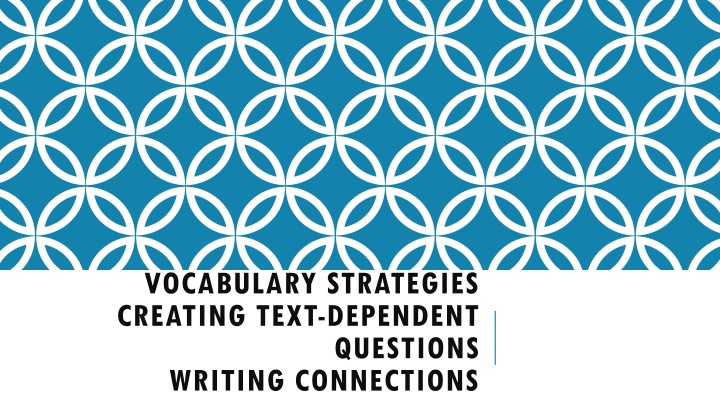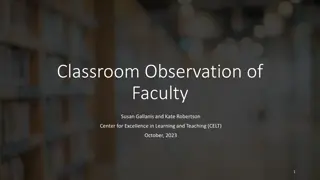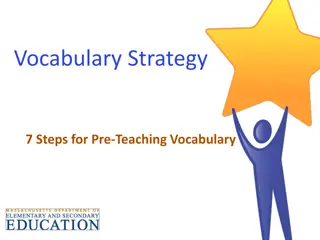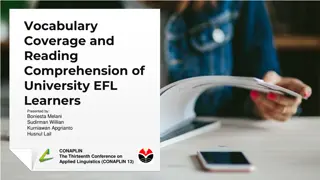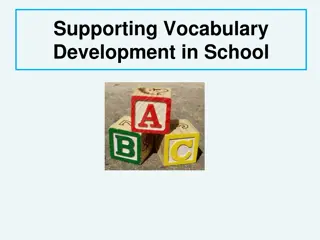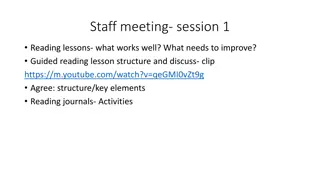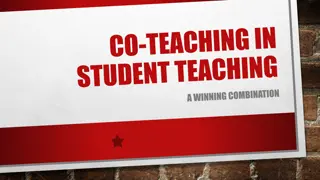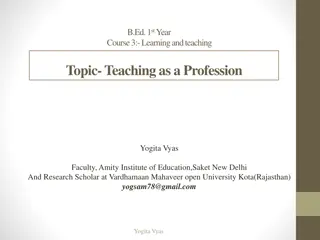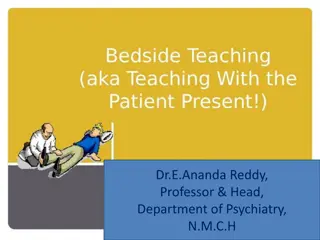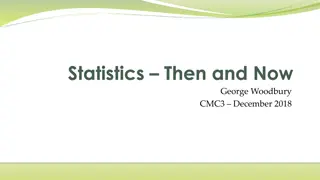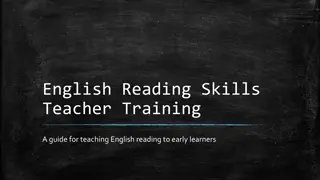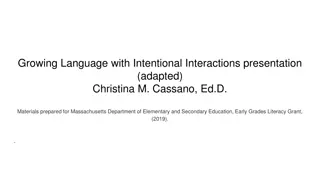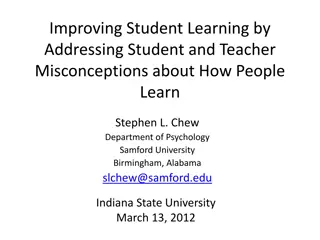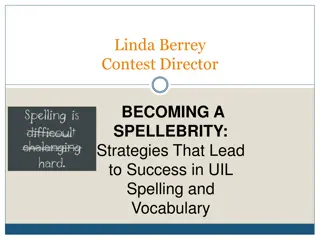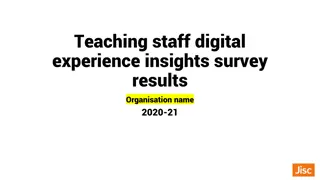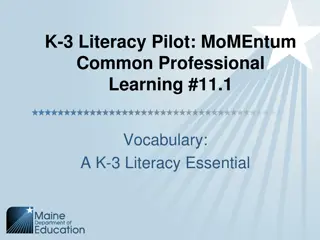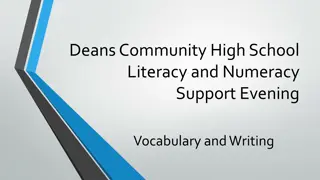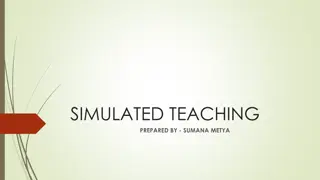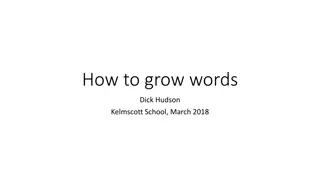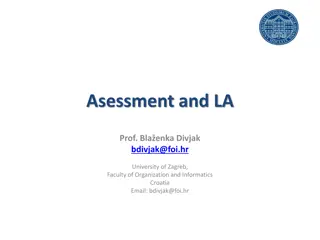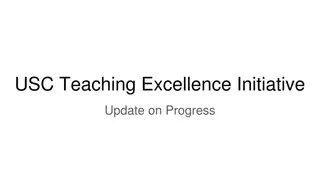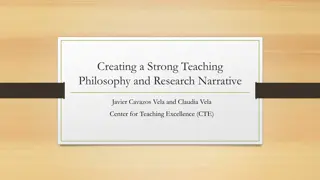Effective Vocabulary Strategies for Teaching and Learning
Explore the significance of vocabulary acquisition, strategies for teaching difficult academic vocabulary, and essential truths about vocabulary use. Discover innovative methods like Picture It and Look Inside and Outside the Word to enhance vocabulary learning in authentic contexts.
Download Presentation

Please find below an Image/Link to download the presentation.
The content on the website is provided AS IS for your information and personal use only. It may not be sold, licensed, or shared on other websites without obtaining consent from the author.If you encounter any issues during the download, it is possible that the publisher has removed the file from their server.
You are allowed to download the files provided on this website for personal or commercial use, subject to the condition that they are used lawfully. All files are the property of their respective owners.
The content on the website is provided AS IS for your information and personal use only. It may not be sold, licensed, or shared on other websites without obtaining consent from the author.
E N D
Presentation Transcript
VOCABULARY STRATEGIES CREATING TEXT-DEPENDENT QUESTIONS WRITING CONNECTIONS
OVERVIEW FOR TODAYS PROFESSIONAL DEVELOPMENT Instructional Strategies for Teaching of Vocabulary Designing Text-Dependent Questions in 7 Easy Steps Connections to Writing Focus
THE IMPORTANCE OF VOCABULARY Because each new word has to be studied and learned on its own, the larger your vocabulary becomes, the easier it will be to connect a new word with words you already know, and thus remember its meaning. So your learning speed, or pace, should increase as your vocabulary grows. Johnson O Connor Vocabulary is the best single indicator of intellectual ability and an accurate predictor of success at school. W. B. Elley
TEACHING DIFFICULT ACADEMIC VOCABULARY IS OFTEN MADE MORE CHALLENGING WHEN TEACHERS Do not use enough academic language when they model and scaffold content-area thinking and doing Too often accept oral and written responses that are not sufficiently academic in nature.
ESSENTIAL TRUTHS ABOUT VOCABULARY ACQUISITION AND USE For language to develop and flourish, it must be recognized as a powerful tool that needs purposeful attention in ALL content areas by ALL teachers. Vocabulary learning must occur in authentic contexts, with students having many opportunities to learn how target words interact with, garner meaning from, and support meanings of other words.
STRATEGIES: PICTURE IT Marzano and Pickering suggested that when you ask students to construct a picture, symbol or graphic representation of a term, they are forced to think of the term in a totally different way. Student-created illustrations will contribute to internalizing word meaning while engaging learners in a multimodal task (Honigsfeld and Dove 2013).
STRATEGIES: LOOK INSIDE AND OUTSIDE THE WORD Direct students to look inside a word to identify root words, prefixes, suffixes, or word parts of compound words they recognize. Have them look outside the word to try to determine the meaning from the sentence or paragraph where they discovered the word or look for any illustrations or other visuals that might provide a clue to the word s meaning. (Honigsfeld and Dove 2013)
STRATEGIES: STUDENT-FRIENDLY DEFINITIONS Dictionary definitions use sentence fragments and synonyms that sometimes need to be defined or explained. Presenting definitions written in student-friendly terms leads to greater access and retention. Example: The dictionary definition for outrageous is not conventional or matter-of- fact. Whereas, a student-friendly definition might look something like this: When something is outrageous, it shocks you. You can hardly believe it has happened. For example, if someone broke into the school and vandalized the main office, that would be outrageous. (Honigsfeld and Dove 2013)
STRATEGIES: CONCEPT MAPS/FRAYER MODEL These are graphic organizers that illustrate relationships among several concepts promote understanding of a word s many levels of meaning go beyond the dictionary definition encourage application of personal knowledge
What is it? (in own words) An educated guess A conclusion you draw based on evidence What is it not? Scientific fact Always correct inference Examples: Facts & Characteristics: To make an inference, we look for clues. We base our conclusion on our past experience(s). The judgments we make should be logical. If we see someone open the door for someone else, we might infer that person is polite or well-mannered. If someone can answer all the teacher s questions, we might infer that person is smart.
STRATEGIES: GRAVEYARD OF DEAD WORDS One problem often noticed in student writing is the use of vague or nonspecific vocabulary. Brainstorm with class tired or over-used words. In pairs or small groups, have each pair/group create a tombstone for one of the tired words, putting the tired/vague word and RIP (rest in peace) at the top of the tombstone. Then they write as many better word choices as they can on the bottom part of the tombstone. Students could consult a thesaurus if needed. These tombstones could be displayed on the classroom walls as a reminder to students to use more complex, vivid word choices. (Honigsfeld and Dove 2013)
FREERICE Warning: This game may make you smarter. It may improve your speaking, writing, grades, job performance, etc.
HELPFUL VOCABULARY WEBSITES http://visuwords.com/ Wordsmith.org : The magic of words. word, language, quote, quotation, anagram, dictionary, words, languages, quotes, quotations, anagrams, dictionaries
WHAT ARE TEXT-DEPENDENT QUESTIONS? HOW DO I CRAFT THEM? Designed around complex text that is fiction or nonfiction Prompts readers to use the text to respond Helps to facilitate close reading by compelling readers to examine and analyze the text to uncover rich meaning From Mapping and Designing Units to the ELA Common Core, 6-12 by Kathy Glass
WHAT ARE TEXT-DEPENDENT QUESTIONS? HOW DO I CRAFT THEM? Non-Text-Dependent Questions Text-Dependent Questions In Casey at the Bat, Casey strikes out. Describe a time when you failed at something. What makes Casey s experiences at bat humorous? In Letter from a Birmingham Jail, Dr. King discusses nonviolent protest. Discuss, in writing, a time when you wanted to fight against something that you felt was unfair. What can you infer from King s letter about the letter that he received? In The Gettysburg Address Lincoln says the nation is dedicated to the proposition that all men are created equal. Why is equality an important value to promote? The Gettysburg Address mentions the year 1776. According to Lincoln s speech, why is this year significant to the events described in the speech?
CREATING TEXT-DEPENDENT QUESTIONS Step 1: Develop essential understandings around the text Step 2: Identify what is noteworthy about the text Step 3: Create a final assessment Step 4: Target vocabulary, sentence syntax, and text structure Step 5: Recognize key details Step 6: Delve into challenging areas of the text Step 7: Arrange questions in appropriate order for instruction (Glass 2013)
ESSENTIAL UNDERSTANDINGS EXAMPLES 1. People search for a place to call home and a sense of family to foster security. 2. Sometimes the truth needs to remain secret to protect people from harm. 3. Effective leaders can help unite disparate groups to achieve a unified goal by using compromise and strategy. 4. The structures and behaviors of living organisms help them adapt to their environments so they can survive. 5. Artifacts from diverse world cultures reveal information and insight about the daily life, beliefs, and customs of a civilization.
CREATE ESSENTIAL UNDERSTANDINGS 1. Read text. Read Assume You re Under Surveillance by Andy Kessler on page 1 of yourpacket. 2. List concepts. Find and make a list of concepts that you glean from this article. 3. Brainstorm statements. Brainstorm a list of statements pertaining to this article using your concept list. You might need the frame: From this reading, students will understand that... 4. Create Essential Understandings. Share your brainstorming statements with those at your table and as a group create a couple of essential understandings for this text.
Brainstorming Governments are using technology to monitor people s communication and location. The issue of citizen s rights must be discussed since there are positives and negatives to the privacy debate. Privacy is being compromised because of the fear of crime. Criminal activity raises real fears. Using surveillance is a way to protect people from crime. It is an injustice to monitor people in intrusive and pervasive ways. People have an active role in how they are monitored. They can minimize their chances of being tracked by selectively using technology. Concepts Surveillance Government Security Fear Skepticism Privacy Rights Crime (Terrorism) Essential Understandings Governments utilize technology to protect people from crime which might infringe on privacy rights. People can select technology carefully to minimize government intrusion of their rights.
ESSENTIAL UNDERSTANDINGS are constructed in complete sentences. focus on at least two concepts. form a relationship between the concepts using strong verbs. have transfer value and prime students to make connections so no proper nouns or past tense verbs are used. (not always) represent what you really want students to understand about the text; answers the question why is this important? or how?
ON YOUR OWN Read the explanation for Step 1 of the Creating Text-Dependent Questions reference packet and note examples given. Use the piece of informational text you brought with you to identify concepts, brainstorm a list of statements using your concepts, and create at least two essential understandings for your text.
CREATING TEXT-DEPENDENT QUESTIONS Step 1: Develop essential understandings around the text Step 2: Identify what is noteworthy about the text Step 3: Create a final assessment Step 4: Target vocabulary, sentence syntax, and text structure Step 5: Recognize key details Step 6: Delve into challenging areas of the text Step 7: Arrange questions in appropriate order for instruction (Glass 2013)
STEP 2: IDENTIFY WHAT IS NOTEWORTHY ABOUT THE TEXT Writing style, e.g., repetition of sentence structure, phrases, particular words Passages that are: Literary Elements Tone Irony ripe for making inferences Flashbacks Imagery are difficult to read because of Foreshadowing Allusion syntax Dialect Metaphor make a significant point or need Bias Simile interpretation complicated because of figurative language
EXAMPLES FROM SAMPLE TEXT Allusion: It s been over 60 years since George Orwell published 1984 Imagery: the National Security Agency is building a massive, $2 billion data center in Utah capable of storing 5 zettabytes of data the equivalent of every email, cell phone call, Google search, and surveillance-camera video for a long time to come.
EXAMPLES FROM SAMPLE TEXT Mood: general feeling of the work; the emotions readers feel while reading; conveyed through dialogue, setting, plot, images. How do you feel as you read it? threatened, exposed the National Security Agency is building a massive, $2 billion data center in Utah capable of storing 5 zettabytes of data the equivalent of every email, cell phone call, Google search, and surveillance-camera video for a long time to come.
ON YOUR OWN Read about step 2 from your explanation sheet and note examples given. Use a pen or post-it note to mark things that are noteworthy in the text you brought with you. Highlight any vocabulary worth knowing.
CREATING TEXT-DEPENDENT QUESTIONS Step 1: Develop essential understandings around the text Step 2: Identify what is noteworthy about the text Step 3: Create a final assessment Step 4: Target vocabulary, sentence syntax, and text structure Step 5: Recognize key details Step 6: Delve into challenging areas of the text Step 7: Arrange questions in appropriate order for instruction (Glass 2013)
STEP 3: CREATE A FINAL ASSESSMENT: EXAMPLES Informative/Explanatory Essays Students use their research and their identification of patterns [emotion word families ] to help them answer the following prompt: How do Douglass' feelings change over the course of this piece? What is Douglass trying to show about how slavery makes people feel? Write a paragraph in which you show how his feelings change and what you believe he is trying to show the reader. Douglass selection from www.achievethecore.org
STEP 3: CREATE A FINAL ASSESSMENT: EXAMPLES Informative/Explanatory Essays Students should write an adequately planned and well- constructed informative essay regarding the meaning of the essay s title - Living Like Weasels. Why has the author chosen this title? Why is it significance? Students should include at least three pieces of evidence from the text to support their thoughts. Dillard selection from www.achievethecore.org
STEP 3: CREATE A FINAL ASSESSMENT: EXAMPLES Opinion/Argument Read Emma Lazarus poem The New Colossus. Stake a claim about the theme of the text. Be prepared to orally defend your interpretations and judgments through evidence from the text. Write a persuasive letter from the point of view of a historical figure from a time in history to another historical figure. Focus your letter on how the situation should be handled using factual information.
ON YOUR OWN Read about Step 3 from the reference packet. Create a final assessment for the text you brought. To do so: Revisit essential understandings and review grade level standards. Determine how students can best demonstrate understanding of text passage via an appropriate text type. Consider length of text. This is a chance for our students to incorporate the POW T-SEC writing strategy. Keep it in mind as your construct final assessments.
CREATING TEXT-DEPENDENT QUESTIONS Step 1: Develop essential understandings around the text Step 2: Identify what is noteworthy about the text Step 3: Create a final assessment Step 4: Target vocabulary, sentence syntax, and text structure Step 5: Recognize key details Step 6: Delve into challenging areas of the text Step 7: Arrange questions in appropriate order for instruction (Glass 2013)
STEP 4: TARGET VOCABULARY, SENTENCE SYNTAX, AND TEXT STRUCTURE Three Tiers of Words Tier One: everyday speech Tier Two: general academic words Tier Three: domain-specific words
TIER TWO WORDS (GENERAL ACADEMIC WORDS) appear in all sorts of texts: informational texts (e.g., relative, vary, formulate, specificity, and accumulate) technical texts (calibrate, itemize, periphery) literary texts (misfortune, dignified, faltered, unabashedly)
Not so long ago in Montgomery, Alabama, the color of your skin determined where you could sit on a public bus. If you happened to be an African American, you had to sit in the back of the bus, even if there were empty seats up front. Back then, racial segregation was the rule throughout the American South. Strict laws called Jim Crow laws enforced a system of white supremacy that discriminated against blacks and kept them in their place as second-class citizens. People were separated by race from the moment they were born in segregated hospitals until the day they were buried in segregated cemeteries. Blacks and whites did not attend the same schools, worship in the same churches, eat in the same restaurants, sleep in the same hotels, drink from the same water fountains, or sit together in the same movie theaters. In Montgomery, it was against the law for a white person and a Negro to play checkers on public property or ride together in a taxi. Freedman, Russell. Freedom Walkers: The Story of the Montgomery Bus Boycott (2006)
STEP 4: TARGET VOCABULARY, SENTENCE SYNTAX, AND TEXT STRUCTURE: EXAMPLE QUESTIONS 1. Why does Douglass describe the master s response as both desired and unexpected ? Why the contrast between these two words? 2. How does the word enable change the meaning of the line it appears in? How can documents enable him to utter [his] thoughts or write?
ON YOUR OWN 1. Read about Step 4 in your reference packet and note examples given. 2. Target vocab., syntax, and structure. Review your student text and make sure you have flagged those words and passages that appeal to this step. 3. Create questions. Create text-dependent questions to satisfy this aspect of deciphering complex text. Convert appropriate general questions from sample questions on explanation sheet to specific, text-dependent ones.
CREATING TEXT-DEPENDENT QUESTIONS Step 1: Develop essential understandings around the text Step 2: Identify what is noteworthy about the text Step 3: Create a final assessment Step 4: Target vocabulary, sentence syntax, and text structure Step 5: Recognize key details Step 6: Delve into challenging areas of the text Step 7: Arrange questions in appropriate order for instruction (Glass 2013)
STEP 5: RECOGNIZE KEY DETAILS Can be a combination of any of these types of questions: Foundational: can prepare for more sophisticated questions Literal: can be answered using direct words from the text Calls on readers to connect ideas or information from the text
EXAMPLES OF QUESTIONS FOR STEP 5 (KEY DETAILS) 1. Why is Douglass specific about making friends with little white boys ? 2. How did Douglass learn how to read when running errands? 3. What features of a weasel s existence make it wild? Make it violent? 4. What instances in the text show a display of weasels being obedient to instinct ?
STEP 6: DELVE INTO CHALLENGING AREAS OF THE TEXT Focus on: dense material inferential opportunities hard to interpret literary devices complicated figurative language challenging sentence structure have sophisticated content. Possible overlap with Step 4 (syntax) if passages with
EXAMPLE QUESTIONS FOR STEP 6 (CHALLENGING TEXT) 1.Put the great law of human action and the difference between work and play into your own words. 2.When she sees the weasel, Dillard says, I've been in that weasel's brain for sixty seconds. What did she find there? 3.In your journal, write an entry describing the effect of seeing the weasel. What experience does Dillard compare it to, and how is this an apt comparison? www.achievethecore.org
GENERIC QUESTIONS TEXT-SPECIFIC QUESTIONS Why does the author use this literary device (hyperbole, allusion, dialect, etc.): _____? What do characters decisions reveal about themselves? Why does Dahl use irony? What effect does it have on the reader? How do Anne Frank s actions and decisions define her character? How and why do our impressions of her change? Cisneros uses the metaphors of an onion, rings of a tree trunk, and stacking dolls to describe growing old. Reread that paragraph and rewrite it in your own words. What literary devices does the author use? Provide an interpretation or rewrite the passage in your own words.
GENERIC ?S TEXT-SPECIFIC ?S Draw evidence from literary or informational texts to support analysis, reflection, and research. Assign a paragraph that asks students to write an analysis of Douglass text. Demonstrate understanding of figurative language, word relationships, and nuances in word meanings. a. Interpret figures of speech (e.g., hyperbole, paradox) in context and analyze their role in the text. At what points in the text does Dillard use similes and metaphors to describe the weasel? Why does she choose figurative language to do this?
ON YOUR OWN 1. Read about Steps 5 and 6 from your reference packet and note examples given. 2. Review your annotations. Review annotations you made for your student text from Step 2. 3. Create questions. Create text-dependent questions to allow students to recognize key details and also examine challenging passages. Convert appropriate general questions from the explanation packet to specific, text-dependent ones. Note: There might be overlap with Step 4 questions.
CREATING TEXT-DEPENDENT QUESTIONS Step 1: Develop essential understandings around the text Step 2: Identify what is noteworthy about the text Step 3: Create a final assessment Step 4: Target vocabulary, sentence syntax, and text structure Step 5: Recognize key details Step 6: Delve into challenging areas of the text Step 7: Arrange questions in appropriate order for instruction (Glass 2013)
STEP 7: ARRANGE QUESTIONS IN APPROPRIATE ORDER FOR INSTRUCTION The sequence of questions should not be random but should build toward more coherent understanding and analysis. An effective set of discussion questions might begin with relatively simple questions requiring attention to specific words, details, and arguments and then move on to explore the impact of those specifics on the text as a whole. Source: Revised Publisher s Criteria
ON YOUR OWN Keeping the research-based evidence about the arrangement of text-dependent questions in mind, arrange the text-dependent questions you have created to accompany your text in the most logical order for your students.
